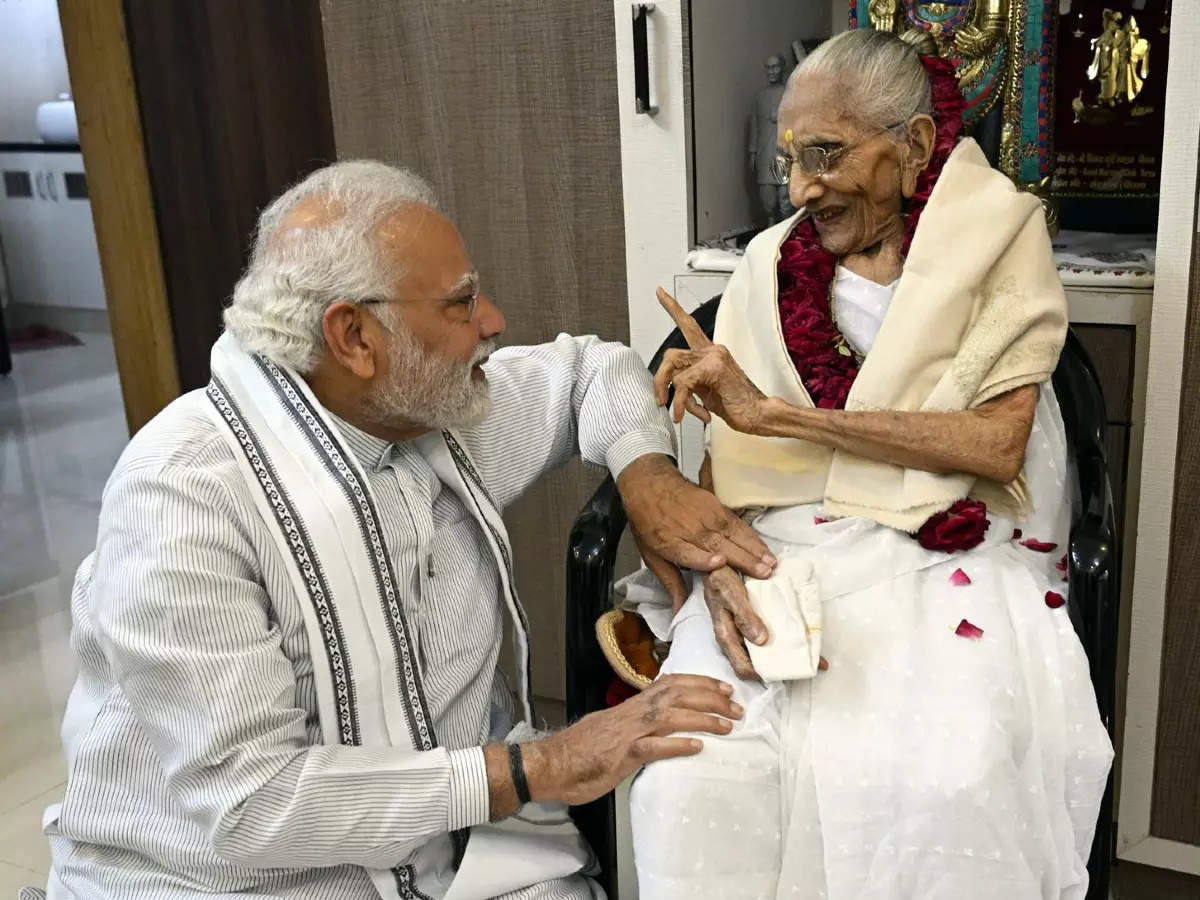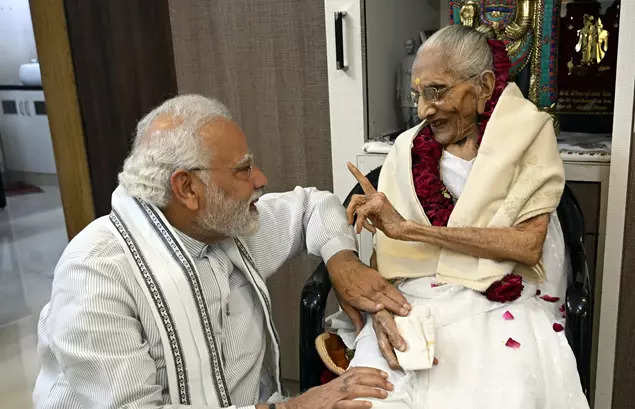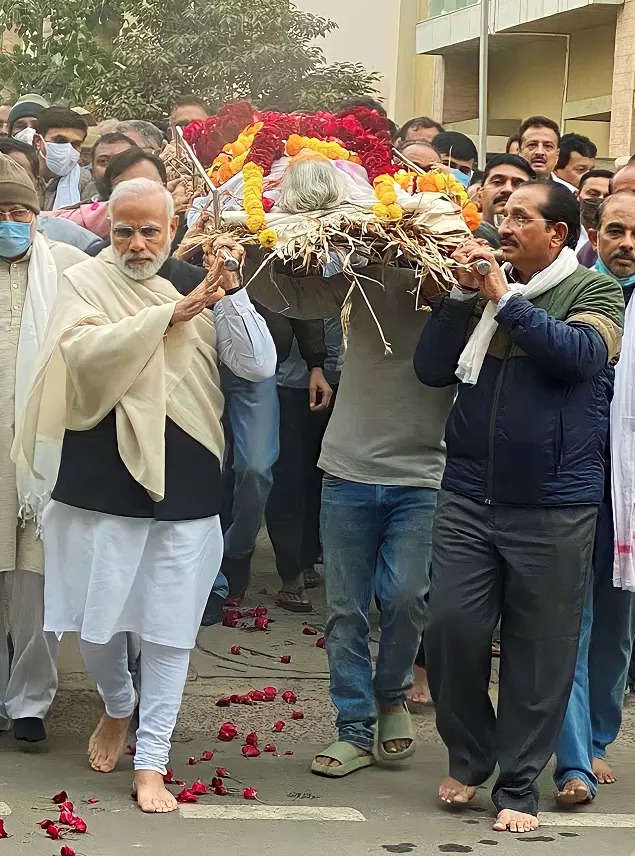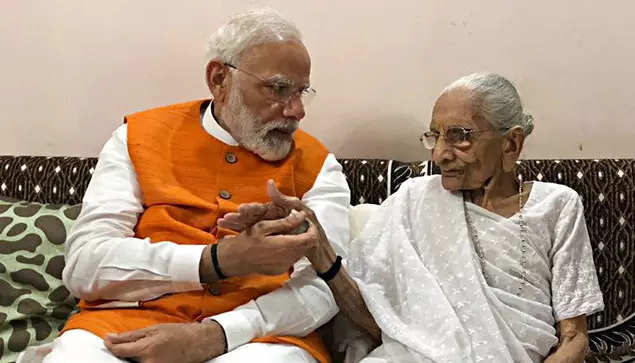
NEW DELHI: Among all his family members, Prime Minister Narendra Modi seemed closest to his mother Heeraben who passed away on Friday in her 100th year. He not just follows her ideals and principles but his government’s flagship schemes also draw inspiration from her.
On June 18, Heeraben’s 100th birthday, Modi wrote a blog titled ‘Mother’. In it, he wrote, “In my Mother’s life story, I see the penance, sacrifice and contribution of India’s matrushakti. Whenever I look at Mother and crores of women like her, I find there is nothing that is unachievable for Indian women.”
He said far beyond every tale of deprivation, was the glorious story of a mother; and far above every struggle, was the strong resolve of a mother. “Her childhood was one of poverty and deprivation… Compared to today, Mother's childhood was extremely difficult,” he wrote.

Several of the projects which the Modi government has launched since coming to power in 2014 seem to have drawn their inspiration from Heeraben’s life.
This is also a reason why several key projects and welfare schemes of the Modi government cater to women.
Ujjwala Yojana
PM Modi launched Ujjwala Yojana on May 1, 2016 in Ballia in Uttar Pradesh to provide free LPG connections to 5 crore BPL (below poverty line) families.
Addressing a rally on the launch of the scheme, Modi said when a poor mother cooks food with wood on a stove, scientists say she inhales smoke equivalent to 400 cigarettes a day. As the children are at home, they too have to survive in smoke. There is smoke all around while everyone eats food. Water keeps coming out of the eyes even as the child eats food, he said.
The PM wrote: “I have experienced all these situations in my childhood. The house where I was born was like a very small corridor. There was no window. There was only one door to enter. And my mother used to cook food by burning a wood stove. Sometimes there used to be so much smoke that we could not see her while she was serving food to us. We had such a childhood in which we used to eat food in smoke.”
Modi said, “And that is why I have reached this far after experiencing very well the pain of those mothers and the pain of those children. I have lived through that pain. That is why I have to liberate these poor mothers of mine from this painful life. And that is why we have launched an initiative to provide cooking gas to five crore families.”
Describing the kitchen, he wrote in his blog, “My father made a machaan from bamboo sticks and wooden planks to make it easier for Mother to cook food. This structure was our kitchen. Mother used to climb on the machaan to cook, and the entire family would sit on it and eat together.”

Swachh Bharat Mission
Heeraben laid a major emphasis on cleanliness and sanitation. Modi, in his blog, wrote, “I can fill many reams of paper recalling anecdotes about Mother’s focus on cleanliness. She had another quality - a deep respect for those involved in cleaning and sanitation.”
He said, “Her (Heeraben’s) focus on cleanliness is evident even today. Whenever I go to Gandhinagar to visit her, she offers me sweets with her own hands. And just like a young child’s doting mother, she takes out a napkin and wipes my face once I finish eating. She always has a napkin or small towel tucked into her saree.”
Modi said Heeraben was extremely particular that the bed should be clean and properly laid out. She would not tolerate even a speck of dust on the bed. A slight crease meant that the bed sheet would be dusted and laid again. “All of us were very careful about this habit as well. Even today, at this age, Mother expects that there should not be a single crease on her bed!” he said.
In fact, Swachh Bharat Mission was the first project to be launched by Modi after coming to power in May 2014. It was launched on October 2, 2014 to accelerate the efforts to achieve universal sanitation coverage and to put the focus on sanitation.
Toilets
Modi and his family had spent their early life without a toilet in their house.
The PM wrote in his blog, “In Vadnagar, our family used to stay in a tiny house which did not even have a window, let alone a luxury like a toilet or a bathroom. We used to call this one-room tenement with mud walls and clay tiles for a roof, our home. And all of us - my parents, my siblings and I, stayed in it.”
The Modi government took up construction of toilets in each and every house on a war footing. The people called it “Izzat Ghar” as it got associated with the dignity and respect of women and girls who went out in the fields to relieve themselves in the absence of toilets in the houses.
Women had to suffer immense hardship in the absence of toilets at homes. They had to wait for sunset to go out. Going out also led to risk to their safety and health hazards.
Under the Swachh Bharat Mission, all villages, gram panchayats, districts, states and Union Territories in India declared themselves open-defecation free (ODF) by October 2, 2019, the 150th birth anniversary of Mahatma Gandhi, by constructing over 100 million toilets in rural India.
Har Ghar Jal Scheme
There was no tap water in Modi’s house. In fact, he would go to a pond nearby to wash dirty clothes.
Modi wrote: “Mother never expected us, children, to leave our studies and assist her with the household chores. She never even asked us for help. However, looking at her work so hard, we considered helping her our foremost duty. I used to really enjoy swimming in the local pond. So, I used to take all the dirty clothes from home and wash them at the pond. The washing of clothes and my play, both used to get done together.”
Connected to the absence of tap water at home is the Har Ghar Jal scheme. Prime Minister Modi announced the Jal Jeevan Mission as a flagship programme of the government of India from the ramparts of Red Fort on August 15, 2019.
The mission aims to make provision of potable tap water supply in adequate quantity, of prescribed quality and on regular and long-term basis to every rural household of the country by 2024. The programme is implemented by the central government in partnership with states and Union Territories.
Houses for poor in the name of women
Most of the woes faced by Modi and his family were because of poverty and were mostly related to their house.
In his blog, the PM said, “Monsoons would bring their own troubles for our mud house.”
However, Heeraben ensured that they faced minimum discomfort. In the searing heat of June, she would clamber over the roof of their mud house and repair the tiles. However, despite her valiant efforts, their house was too old to withstand the onslaught of the rains.

During the rains, the roof would leak and the house would flood. Heeraben would place buckets and utensils below the leaks to collect the rainwater. “Even in this adverse situation, she would be a symbol of resilience. You will be surprised to know that she’d use this water for the next few days. What better example than this of water conservation!” he wrote.
No wonder, the Modi government launched its flagship mission – Pradhan Mantri Awas Yojana- Urban (PMAY-U), under the ministry of housing and urban affairs (MoHUA), on June 25, 2015.
The mission addresses urban housing shortage among the economically weaker sections (EWS), low income group (LIG) and middle income group (MIG) categories including slum dwellers by ensuring a pucca house to all eligible urban households.
Going a step ahead, the government made it compulsory for the beneficiaries of PMAY-U to register the house in the name of a female member of the family.
Aatmanirbhar Bharat Abhiyan
The PM has written extensively about his mother being self-reliant. She used to wash utensils in a few houses to help meet the household expenses. She would also take out time to spin the charkha to supplement the family’s meagre income.
Heeraben would do everything from peeling cotton to spinning yarn. “Even in this back-breaking work, her prime concern was ensuring that the cotton thorns don’t prick us. Mother avoided depending on others or requesting others to do her work.”
He further wrote: “This striving for perfection prevails even now. And though she stays with my brother’s and my nephew’s families in Gandhinagar, she still tries to do all her work herself at this age.”
Modi writes how Heeraben was fond of decorating the house and would devote considerable time towards cleaning and beautifying it. She would smear the floor with cow dung. Cow dung cakes emit a lot of smoke when burnt. She would cook with them in her windowless house.
He talked about recycling of old household items. “The walls would get blackened by soot and require fresh whitewashing. This too Mother would do herself every few months. This would give our dilapidated home a scent of freshness. She would also make pretty little clay bowls to decorate the house. And she was a champion in the famous Indian habit of recycling old household items.”
He recalled another unique habit of Heeraben which was to make a glue-like paste with old paper dipped in water and tamarind seeds. She would make beautiful paintings by sticking mirror pieces on the walls with this paste. She would get small decorative items from the market to hang on the door.
The Atmanirbhar Bharat Abhiyan or Self-reliant India campaign, envisaged by the PM on May 12, 2020, seems to draw inspiration from Heeraben.
The PM raised a clarion call to the nation giving a kickstart to the Atmanirbhar Bharat Abhiyan and announced the special economic and comprehensive package of Rs 20 lakh crore - equivalent to 10 per cent of India’s GDP – to fight COVID-19 pandemic in the country.
The aim of the mission is to make the country and its citizens independent and self-reliant in all senses. There are 268 activities in the campaign which include empowering women farmers by DIY (Do It Yourself) products made from domestic waste, professional cake training and education on basic tailoring training.
Women in constitutional posts
The importance which PM Modi attaches to women because of his closeness to his mother is also evident from some of the appointments to constitutional posts during his tenure.
There has always been a woman in the crucial Cabinet Committee on Security (CCS). If it was late Sushma Swaraj as the external affairs minister in his first term, it is Nirmala Sitharaman as the finance minister.
The Lok Sabha speaker’s post also went to Sumitra Mahajan between 2014 and 2019. In the latest appointment, Droupadi Murmu has taken over as the first tribal woman president of the country.







